
Safety often overlooked by Glades visitors
HOMESTEAD, Fla. — With winter break around the corner, more and more families are looking for a place to relax, kick back, and enjoy time together in a beautiful, yet fun setting.
Our national parks provide visitors with just that.
Whether it’s hiking, canoeing, or getting a picnic together, Everglades National Park, the third largest park in the lower 48 states, is the prime location for an adventurous family outing.
| At right, an alligator in Everglades National Park’s Shark Valley (Photos by Alexis Kanarek). Below, an alligator in one of the park’s wetlands. | 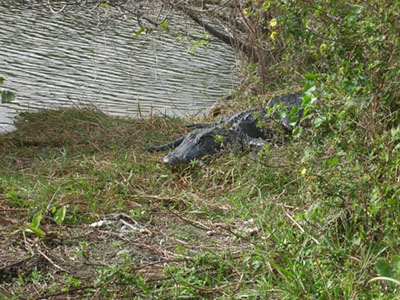 |
There are four South Florida park areas to visit and the Everglades will prove to be a unique experience at each one. This network of wetlands and forests, fed by a river flowing out of Lake Okeechobee towards the Florida Bay, contains the largest mangrove ecosystem in the western hemisphere, supports hundreds of different bird, fish, mammal and reptile species, and is home to over 35 endangered or protected species, including the American crocodile, the Florida panther and the West Indian manatee.
Activities range from tram and boat tours, to camping and fishing, to bird watching and alligator spotting.
However, not all is fun and games when at the Everglades.
Safety is an issue that is often overlooked by both first-time and regular visitors.
“When I first started helping out at the Everglades, there was a death in Florida Bay, when someone jumped into the water and swam after something and drowned,” said Mary Plumb, one of the park’s public information officers. “The body wasn’t found until a few days later and it kicked in a major search and rescue type effort that the law enforcement rangers and multijurisdictional agencies got involved in.”
This accidental death is just one of the many avoidable tragedies that occur in national parks each year. Listening to park rangers’ advice and their various safety tips helps to ensure a positive, accident-free experience, allowing visitors to enjoy all the park has to offer.
It’s always fun to escape city life and go kayaking, cycling, or boating. However, national parks are natural environments that pose risks that tend to go ignored. These remote and rugged places are full of rivers, cliffs, and wildlife, and are subject to unpredictable changes in weather.
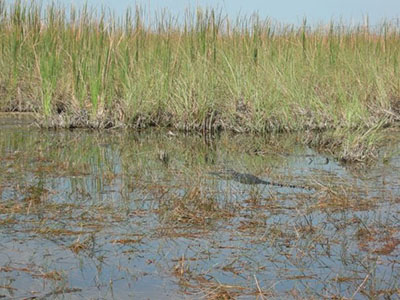 “In the past five years we have only had one visitor with a reportable injury caused by wildlife,” said Linda Friar, Everglades National Park public information officer. “A visitor walking through the campground at night wearing flip-flops stepped on a rattlesnake and was bitten.”
“In the past five years we have only had one visitor with a reportable injury caused by wildlife,” said Linda Friar, Everglades National Park public information officer. “A visitor walking through the campground at night wearing flip-flops stepped on a rattlesnake and was bitten.”
Seemingly common sense, there are various necessary precautions one must take. For example, not wearing flip flops, treating the animals with caution and respect, bringing the right gear, wearing sunscreen and protective clothing, and remembering to plan ahead by choosing activities that match one’s stamina and fitness level.
Rules as obvious as staying within the boundaries of the park’s trails have eluded visitors in the past and continue to pose risks for those eager to get that perfect picture.
“So the rangers are constantly having to inform parents to keep their kids away from the wood rails [on the trails],” said Plumb. “Don’t put your kids up on the wood rail to get a picture of you and the alligator in the background.”
Although pictures and souvenirs seem invaluable at the moment, in reality, they pale in comparison to the importance of keeping one’s self, and those they are with, safe.
“Our injury rate is very low overall and lower than many national parks of similar size and character,” said Friar. “We experience very few injuries caused by wildlife. National parks in the West tend to experience more injuries due to the nature of the wildlife (bears, etcetera).”
Even though injuries aren’t as common in Everglades National Park, for rangers, visitor safety is an important part of managing the park and a constant struggle.
Due to the vast opportunities to explore the wilderness of these undeveloped areas, visitors often face the risks that accompany venturing into the unfamiliar.
“There is a lot of information provided at the initiation sites for any kind of walks and plenty of information on anything to do with harming, molesting, or getting in the way, in any way, of the wildlife,” said Plumb. “It is illegal and you will receive a fine and there will be law enforcement rangers who will be walking the trails and enforcing them.”
Additionally, there are interpretive rangers walking the trails, throughout the park, attempting to tackle this issue from an educational standpoint.
At the Everglades, vital park functions include search and rescue (SAR) missions, which are regularly conducted by law enforcement rangers and involve responding to requests for assistance by lost or sometimes injured visitors. These operations often take place in isolated and remote areas, accessible only by boat or aircraft, within the vast wilderness of the park.
In order to improve the park’s ability to respond quickly and effectively to these situations, with the necessary supplies and manpower, and to educate visitors and the community as a whole on the importance of safety when visiting the Everglades, the park accepts donations for their SAR program on their website.
| At right, alligator hunter Shane Sultan approaches an alligator at Shark Valley. Below, Sultan getting closer to the alligator, showing what visitors of the park should avoid doing. Last, an alligator that Sultan hunted in the Everglades areas outside the park. | 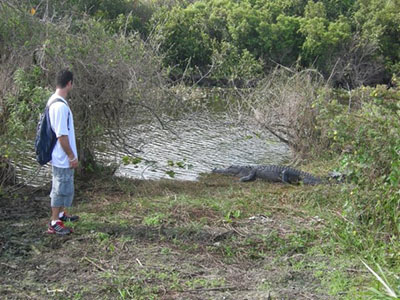 |
However essential and competent these public safety services may be to visitors of the park and nearby communities, they can only do so much. It is up to visitors to take their safety into their own hands by being responsible and aware of the possible risks involved in going to a national park.
Regardless of the activity, visitors need to be aware of their own personal safety at all times.
Whether it’s fishing, boating or camping, the park provides explicit instructions to prevent and protect visitors from harming themselves, the wildlife, and the environment.
“Generally injuries result when visitors approach wildlife too closely, or are intentionally provoking the animals and the animals respond in a defensive manner,” said Friar. “We encourage visitors to follow the park guidelines with regards to safe wildlife viewing.”
In these situations, however, visitors aren’t the only ones who get hurt.
“Animals are frequently harmed by visitors such as animals struck by cars, but in the one snake bite incident the snake was held for identification and then released by a ranger unharmed,” said Friar.
Park regulations prohibit visitors from touching, feeding or harassing any of the wildlife. Their safety and regulations brochures list the park’s policies when engaging in any of the various activities they offer.
These include: attending to fires at all times, not tying lines or attaching anything to the trees for any reason, and not leaving garbage out, which would attract animals, just to name a few.
“Park brochures and exhibits advise visitors to stay a certain specified distance from wildlife for safe viewing,” said Friar. “We also sometimes install temporary fences or barriers to separate people and wildlife and many of our most popular wildlife viewing areas have permanent boardwalks, fences and barriers to ensure visitor safety.”
On ranger walks, specifically, warnings are constantly reiterated due to the activity’s proximity to the park’s wildlife.
“We are constantly informing visitors of safety tips and regulations, especially on the ranger walks,” said Plumb. “For example, what the rangers will tell you during the ranger walks is that the animals have become so acclimated to the multitudes of people that they see walking on that trail, that the animals, who are in their natural domain, see us as being the ones in the suit.”
The animals that inhabit the commonly walked paths of the Everglades are accustomed to the multitudes of people and tend to view them, not themselves, as the park’s entertainment.
“They are living their lives alongside the trail and population of human beings walking down this boardwalk, so they come very close to the trail, much closer than they would if you were anywhere away from the trail,” said Plumb. “If you were out there in the natural area, where they are more dispersed and not used to being near people, there is no way they would come that close, but because of that particular location [of the trail] they are used to people so they come very close to the trail.”
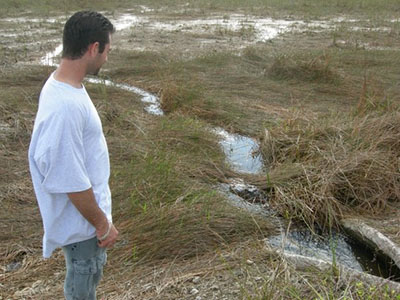 However accustomed to the human visitors these animals may seem, they are still dangerous, wild animals, two facts people tend to overlook, but shouldn’t; considering the most common activities are walking and hiking the trails, with over 70 percent of visitors partaking in them, according to the Everglades National Park Visitor Study.
However accustomed to the human visitors these animals may seem, they are still dangerous, wild animals, two facts people tend to overlook, but shouldn’t; considering the most common activities are walking and hiking the trails, with over 70 percent of visitors partaking in them, according to the Everglades National Park Visitor Study.
“A lot of tourists love to go out into the Everglades and go on tours to see the alligators, but it’s very important that you don’t try to get too close to the animals,” said Shane Sultan, a 31-year-old alligator hunter who frequents Everglades National Park.
Sultan, who regularly visits Shark Valley, located in the north of the park along U.S. 41, has witnessed, first hand, some of the possible risks that accompany venturing into national parks full of wildlife.
“Even though the officials at the park tell you not to touch or get close to the alligators, one of my times at Shark Valley, I saw this man go up to one of the alligators anyways and touch it,” said Sultan. “Even though he didn’t get hurt, it was a very bad idea because it could have ended in tragedy.”
However, not everyone is as fortunate.
“There was one year over by Markham Park, which borders the Everglades, that a young woman was out jogging and she ended up being attacked by an alligator,” said Sultan. “When the trappers and FWC (Florida Wildlife Commission) finally got the alligator, they brought it to the alligator processing plant where I worked at the time.”
Unfortunately, the victim did not survive.
“Nobody really knows what happened,” said Sultan. “She was probably out jogging and fell into the water, which was very close by and inhabited by alligators.”
Fatalities, although uncommon in Everglades National Park, could, for the most part, be prevented if people are careful and avoid the known areas in which alligators and other animals tend to gather.
“When you are out in the park you want to avoid areas such as alligator nests, the mother is always very protective of her eggs and if anyone comes too close she could potentially attack,” said Sultan. “These nests could be anywhere, either near the trails or far from them.”
Nests aren’t the only areas visitors should avoid.
“During the dry season the wildlife often congregates around water holes or other habitat areas that are in close proximity to the public,” said Friar. “This enables visitors to see a large variety of animals in their natural setting and up close, however it can lead to human and wildlife interaction.”
Sultan, like many others in his profession, has also experienced emergency situations and has required some rescuing of his own.
“I was alligator hunting in the middle of Lake Okeechobee at nighttime, which is when the legal hunting hours are, and we were on an airboat going pretty fast through all the saw grass, which was six to eight feet high, in search of a good sized alligator and we couldn’t see anything around us,” said Sultan. “There was a fenced in pipe in the middle of the lake and we crashed straight into it.”
The airboat ended up getting stuck on the fence, the bow of the boat going up in the air while the stern went down, causing it to sink.
“The boat ended up sinking in the middle of the lake, which is full of alligators and snakes, specifically water moccasins, in the middle of the night,” said Sultan. “So there was nothing you could do at that point, the boat was basically capsized and full of water.”
With just the captain and another passenger aboard, Sultan recalls trekking in the marsh frantically trying to get the water out of the boat to lift it, but being unable too.
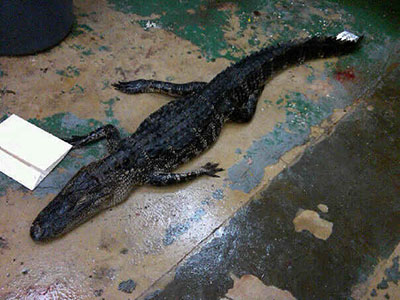 “There was nothing we could do to bale all the water out of the boat so we decided to call the law enforcement and coast guard to come looking for us because we didn’t know our exact location,” said Sultan. “It was a very big lake so the helicopter had to come looking for us and when it finally found us, it sent the FWC over on their airboat to come and rescue us.”
“There was nothing we could do to bale all the water out of the boat so we decided to call the law enforcement and coast guard to come looking for us because we didn’t know our exact location,” said Sultan. “It was a very big lake so the helicopter had to come looking for us and when it finally found us, it sent the FWC over on their airboat to come and rescue us.”
Although most park visitors wouldn’t partake in such dangerous activities, like Sultan’s alligator hunting, this accident like so many others was avoidable.
“It would have been nice to have a GPS and know exactly where we were,” said Sultan. “We were riding through this tall saw grass, at night, and there were no flashing beacons, no warning signs or anything like that.”
According to Sultan, one should be respectful of the alligators, whose habitats have been encroached on, due to expanding developments.
“Obviously we are invading on their territory by expanding developments into their habitats, so once you are in the park there are alligators all over the place and there are times when they are actually in the middle of the path,” said Sultan. “The trail winds throughout the inside of the Everglades and you are basically surrounded by them and the wildlife that inhabits them.”
Through his years of experience with alligators in Florida’s southern wilderness, Sultan has compiled a few safety tips of his own.
“So you want to be very careful by not getting too close to them or provoking them,” said Sultan. “You obviously don’t want to feed them or let them to get used to you and coming up to you because that is when they could really become a potential threat.”
If You Go
Everglades National Park
Address: 40001 State Road 9336, Homestead, Fla. 33034
Phone: 305-242-7700
Website: http://www.nps.gov/ever/index.htm
Safety and Regulations: http://www.nps.gov/ever/planyourvisit/safetyregs.htm
Advisory: If there is an accident or injury, visitors are urged to call 911
Safety Tips:
- Wear Sun protection
- Bring adequate attire and supplies (sturdy footwear, hat, water…)
- Check the weather conditions and dress accordingly
- Keep hydrated and bring salty foods, which will prevent water loss
- Don’t overestimate your abilities
- Avoid alcohol or narcotics
- Drive carefully
- Don’t interact with any of the wildlife
- Follow instructions and abide by park’s safety guidelines and regulations

Comments are Closed